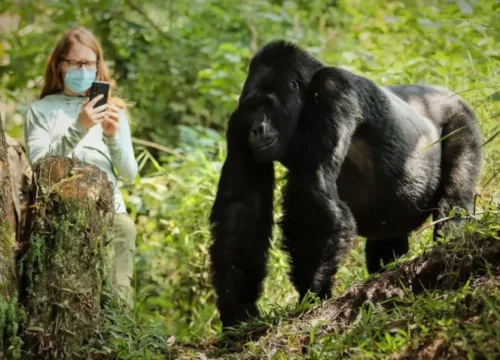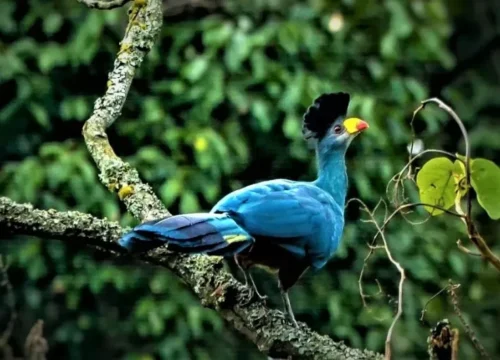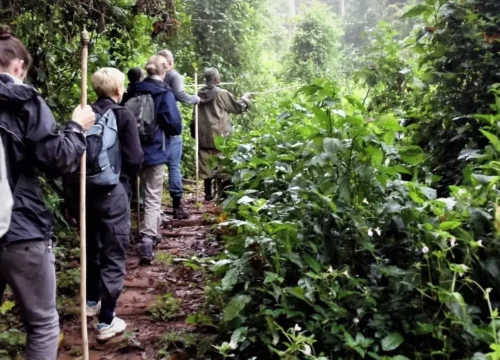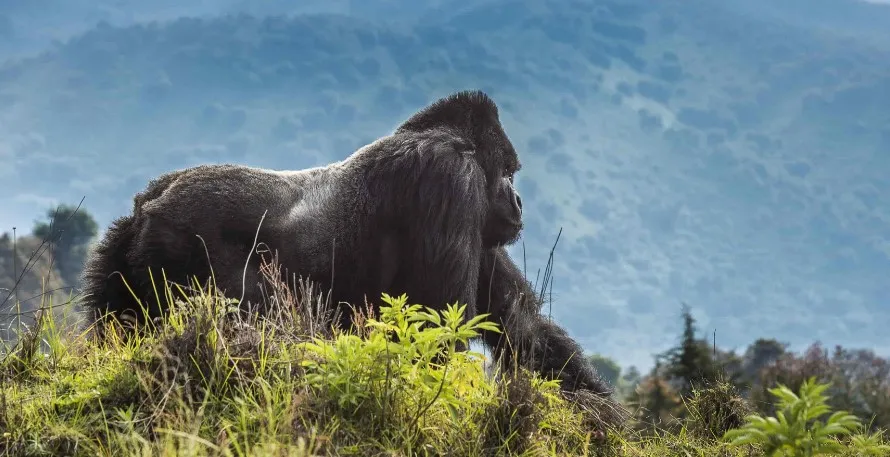Bwindi Impenetrable forest National Park
Bwindi Impenetrable Forest National Park, situated in southwestern Uganda, is a vast and diverse nature reserve spanning 321 square kilometers. This magnificent forest, covering an area of 32,092 hectares, is one of the largest and most pristine afro-montane lowland forests in East Africa.
Bwindi’s unique geography, with an altitude range of 1,160 to 2,607 meters above sea level, creates a variety of habitats that support an incredible array of flora and fauna. The forest is home to:
– Over 163 species of trees, including giant mahogany, ironwood, and fig trees
– 214 species of birds, including the endangered African green broadbill and Grauer’s rush warbler
– 120 species of mammals, including the critically endangered mountain gorilla, chimpanzee, and African elephant
– 202 species of butterflies, including the iconic African giant swallowtail
The park’s most famous inhabitants are the mountain gorillas, one of the world’s most endangered species. Bwindi is home to several habituated gorilla groups, making it a premier destination for gorilla trekking and wildlife tourism.
The forest has a rich cultural and historical significance, with evidence of human habitation dating back to the Stone Age. The park’s name, Bwindi, is derived from a legend about a family who sacrificed their daughter to the swamp spirit, “Mubwindi bwa Nnyinamukari,” which translates to “the dark place of Nnyinamukari.”
Bwindi Impenetrable Forest National Park has a long history of conservation, dating back to 1932 when it was declared a forest reserve. In 1961, it was designated a wildlife sanctuary, and in 1991, it was officially gazetted as a national park. Today, the park is managed by the Uganda Wildlife Authority and is a UNESCO World Heritage Site.
The park’s unique blend of natural beauty, cultural significance, and conservation efforts makes it a must-visit destination for nature lovers, wildlife enthusiasts, and adventure seekers.



Attractions in Bwindi Impenetrable Forest Forest National Park, Uganda
Mountain Gorillas
Mountain gorillas are shy vegetarian apes that are less offensive as they appear to be. But when provoked, the gorilla rises to erect position and beat its cupped hands on the chest to frighten the enemy. The male gorilla weighs between 140 to 275kg and the female gorilla is 40 to 50 % smaller than the male one. Gorillas whether male of female have enough energy to pull trees and rip tree branches. They spend most of their daily time foraging, however they make resting breaks.
Bwindi Impenetrable forest national park is home to more than half of of the 1008 mountain gorillas that live freely in the world.
The four regions of Bwindi inhabit a total of 12 gorilla families that have been habituated for trekking and these include;
- Ruhija- Bitukura, Oruzogo and Kyaguriro
- Buhoma- Mubare, Habinyanja and Rushegura.
- Nkuringo – Nkuringo Gorilla group.
- Rushaga – Nshongi, Mishaya, Kahungye, Bweza and Busingye
Buhoma Region
Mubare Gorilla Family. It is the oldest gorilla family with 8 members and 1 silverback. It is the first family to be habituated for trekking in 1991 after this family was first sighted in the Mubare hills of the park. It received its first official visit two years later in 1993. Kanyonyozi is the family head (silverback of the Mubare group) and he succeeded Ruhondeza who abandoned the family after serious attacks.
Because of easy connection to Buhoma region from queen Elizabeth national park, gorilla permits are on a high demand and trekking this group needs advance booking.
- Habinyanja Gorilla Family.
This has 18 members with two silverbacks. This family started receiving visitors in 1999 (3 years after habituation). Nyanza from which this gorilla family`s name was derived means a pool of water-referring to that in Buhoma region where this gamily was first sighted. This groups however splint into two and formed another group called Rushegura.
- Rushegura Gorilla Family.
Rushegura has 19 members with 1 silverback. This group started in 2002 after separation from Habinyanja. It is a very calm family of gorillas and it lives in close proximity of Buhoma village. This group is sometimes seen in the gardens of Gorilla Forest Camp, this gives chance for guests to watch from their room.
Ruhija region of Bwindi Impenetrable Forest National Park
- Bitukura Gorilla family.
Bitukura has 14 members with 4 silverbacks. This group was first sighted around river Bitukura in 2007 and that’s how this family name came about. The group members of this group are first learners, at on 15 months of habituation, these gorillas were ready for tracking and yet others take 2 years. This family group had 24 members but because of instabilities in the family, they went on separating up to the current number.
- Oruzogo Gorilla Family.
Oruzogo contains 23 members with one silverback called Tibirikwata who is also the head of the family. The official trekking of the Oruzogo family started in 2011 and it is one of the most entertaining gorilla groups because of a number of juveniles and toddlers in this group that are more playful.
Kyaguriro Gorilla Family. Kyaguriro is a 15-member gorilla family with 2 silverbacks. For the past years, this family has been used for research but not it is even open for trekking by the tourists.
Nkuringo Region
- Nkuringo Gorilla Family.
This is a group to 19 members with 2 silverbacks and trekking this family started in 2000. What fueled this group was mainly because it used to encroach people’s plantations and spoil their crops like potatoes. This group had two twin baby gorillas (Katungi and Muhoozi) unfortunately katungi died. Trekking this gorilla family is considered as the most challenging however trekkers have not complained, because of the experience.
Rushaga Region
- Nshongi Gorilla family.
This family derived its name from the local river Nshongi where the group was first sighted. It has 18 members and it is one of the oldest gorilla families to be habituated. The family has 4 silverbacks and the head is called Nshongi, the leading silverback is surprisingly not the oldest but bit has lived in harmony with the remaining 3 silverbacks, and that’s a true sign of leadership. Nshongi gorilla family had a big number of members but they went on separating and the last groups to separate from the Nshongi group is the Mishaya in 2010 and the Bweza in 2013.
- Mishaya Gorilla Family.
It has 7 members with 1 Silverback. Mwiine is the leading silverback who succeeded from Mishaya a strong fighter who would raid other groups and conquer females into his family. Unfortunately, he died in 2014 and Mwiine had to take over.
- Kahungye Gorilla Family.
It has 13 members with 3 silverbacks. This name is derived from a local hill called Kahungye. Rumanzi is the dominant silverback of the family. Official trekking of this gorilla family started in 2011. This group was big with 27 members but later it separating and other groups were formed mainly Busingye and Kahungye.
- Bweza Gorilla Family.
This is a family of 7members headed by 1 silverback. The members of this family split from the Mishaya gorilla family in 2012. It was anticipated by the management of the Uganda Wildlife Authority (UWA) that at some day this group will later go back to re-unite with the Mishaya group but this has not happened and the Bweza group is now an independent gorilla family, well habituated and available for visitors to trek.
- Busingye Gorilla Family.
In this gorilla family group, the members are 9 headed by 1 Silverback. This group was established in June 2012 after the adult members split themselves from the Kahungye group. The family has 2 female adults, 1 silverback and the rest of the members are juveniles. Busingye is a local word which means peace, however the name of this group is contrary to what the group members do, it is among the most provocative family groups which like fighting other gorilla families in the impenetrable forest.

Batwa Cultural Experience
Batwa cultural experience is famous among the best things to do & see while in Bwindi Impenetrable National Park. The Batwa cultural experience allows the displaced Batwa people share their heritage and tradition with the outside world. They display their traditional hunting and living skills, the huts they stayed in, the foods they ate and the traditional medicine they used to treat diseases in case one get sick while staying in the forest.
Bwindi impenetrable forest is surrounded by communities of Bakiga and batwa people. The batwa are an indigenous group of people that once lived with the endangered mountain gorillas in the Bwindi forest before it was made a national park in 1991.
Batwa are also known as the forest keepers. Going on a batwa cultureal experience to the community near Bwindi Impenetrable forest allows you learn about their history, culture and their daily lifestyle. Batwa culture experience is the highlight of all the cultural experiences in Bwindi Impenetrable national park and is done by different local organizations. These include; Batwa Development Program (BDP), Batwa rock settlement walk, Buhoma community walk and Batwa culture among others.
Visitors are required to pay a fee in order to do Batwa cultural experience in Bwindi. This helps these batwa people earn a living since they were displaced without compensation by the government. Visitors are led by a mutwa guide into the forest as he/ she explains their past lifestyle in relation to the present day life.
You will visit batwa homestead to learn about all of these and see how they prepare a local meal and serve it. The cultural visits can be done alongside gorilla trekking, it takes around 4 hours but can be shorted or extended depending on visitor interests.
You can schedule the this tour after a gorilla trek or on the next morning before you proceed to your next destination for visitors heading to Lake Bunyonyi or Queen Elizabeth national park.
Birds in Bwindi Impenetrable Forest
Bwindi Impenetrable National Park is one of the most ideal afro-montane birding areas in the continent of Africa. The park is home to 350 species of birds of which 23 bird species are endemic to the Albertine rift and 14 species only endemic to this park in the whole of Uganda. Some of the rare bird species that are found in Bwindi impenetrable Forest National park include; African Green Broadbill and Shelley’s Crimson wing. There are also other interesting bird species like Handsome Francolin, Black and Cinnamon-chested Bee-eaters, Black-billed Turaco, Western Green Tinker bird, African Broadbill, Regal Sunbirds, western Green Tinker bird, Purple-breasted, Short-tailed and Black-faced Rufous Warblers, yellow-streaked Greenbuls, Mountain-masked and Collared Apalis, red-faced woodland Warbler, colored Bush-Shrike, Ruwenzori batis, handsome Francolin, Mountain and Yellow-streaked Greenbuls and white-tailed crested Flycatcher among others. Ruhija region is a great birding area with many counts of bird species.
Tourist activities in Bwindi impenetrable Forest national Park
Gorilla tracking in Bwindi
Gorilla trekking is the major tourism activity in Bwindi Impenetrable Forest National Park and it has set this park above many protected areas in the world. Bwindi national park is home to over half of the 1008 mountains gorillas that still thrive freely in the whole world. Bwindi is the most ideal park for gorilla trekking in Uganda and the whole world as a whole. Bwindi has fully habituated mountain gorillas available for tracking from four respective regions namely Buhoma, Ruhija, Rushaga and Nkuringo.
Only 8 people are allowed to track a single gorilla family in a day spending strictly one hour while interacting with the gorillas. The starting time for gorilla trekking in Uganda is 8am with a briefing at the park headquarters and the entire gorilla trekking process takes between 2 to 8hours.
Every visitor requires a gorilla permit to track mountain gorillas and this permits costs 600USD per person. Gorilla tracking in Uganda is done all year round but best done in the dry season.
Nature walks in Bwindi
There are mainly six nature trains that are designed to enable visitors explore Bwindi impenetrable Forest National Park. These include Munyange waterfall trail in Buhoma region- good for primates and birdwatching, Rushura Hill trail which provides with the opportunities to view the peaks of Rwenzori and Virunga Mountain ranges, and lakes like lake Edward and lake Gorge as well as the scenery of the Rift Valley floor. Muzabajiro loop also allows the views of Virunga ranges, primates and birds. At the top of this trails, picnicking is much rewarding. Other trails include Ivi River walk, Buhoma-Nkuringo Trail and Habinyanja trail.
Birdwatching in Bwindi Impenetrable Forest National Park
Birders in Bwindi national park are exposed to over 350 species of birds of which 23 species are only found here. Birding in Bwindi is best done in the evening of early morning through the trails in the park and this would provide a memorable experience to visitors on a birding tour. Visitors in Bwindi for birding should expect to encounter birds such as African blue and white-tailed blue flycatchers, African Emerald cuckoo, Short tailed warbler, Blue headed sun bird, Red headed blue bill, Common Bulbul. Birding spots in Bwindi include the Buhoma waterfall trail, and Mubwindi swamp trail in Ruhija.
Cultural Encounters
Diverse cultural groups surround Bwindi National Park, they include the Bakiga, Bafumbira and the Batwa with their interesting traditions that are designed to entertain visitors to Uganda with a memorable rewarding experience. Some of the community groups that provide visitors with rich Ugandan cultural traditions in Bwindi include Buhoma Community Tours / Mukono Development Association, Nkuringo Community Conservation and Development Foundation (NCCDF), Buniga Forest Nature Walk, Nkuringo Cultural Centre (NCC), Nyundo Community Eco-Trail and Rubuguri Village Walk (NCC) among others.
Accommodation/ where to stay in Bwindi
There are various accommodation facilities in Bwindi impenetrable National Park from High end, midrange/ standard and budget facilities. Some accommodations facilities in Bwindi National park include;
Buhoma Region: Ride for a Woman Homestead for Budget Option, Buhoma Haven Lodge, Engagi Lodge, Silverback Lodge for Midrange, for upmarket options Buhoma Lodge, Sanctuary Gorilla Forest Camp, Mahogany Springs, Volcanoes Safaris Bwindi Lodge, Trackers Safari Lodge.
Nkuringo Region: Clouds Mountain Gorilla Lodge, Nkuringo Gorilla Lodge, Nshongi Camp, Chameleon Hill Lodge
Ruhija Region: Ruhija Gorilla Safari Lodge, Gorilla Friends Lodge, Ruhija Gorilla Mist Camp, Trekkers Tavern cottages, Gift of Nature Lodge, Ruhija Community Rest Camp, Rubugiri Area, Wagtail Eco-safari camp.
Rushaga Region: Gorilla Safari Lodge, Ichumbi Gorilla Lodge, Four Gorilla Lodge
How to get to Bwindi Impenetrable Forest.
Bwindi National Park has 4 regions namely; Buhoma, Ruhija, Rushaga and Nkuringo. These regions can be accessed by visitors from different areas of the country and they include the following.
By road
From Kampala, Buhoma region is located 527km 10hrs drive), Rushaga is 510km, Ruhija is 473km and Nkuringo is 517km.
From Kigali in Rwanda, Buhoma is located 232km (5hours drive), Ruhija 170km, Rushaga 169km and Nkuringo 214km.
From Kibale National Park, Buhoma is located 280km (7hours drive), Ruhija 338km, Rushaga 429km and Nkuringo 436km.
From Mweya (Queen Elizabeth National Park), it takes 160km (5hours) of drive to reach Buhoma, 309km to reach Rushaga, 218km to reach Ruhija and 316km to reach Nkuringo.
All the routes heading to Bwindi Impenetrable National park require visitors to use a 4×4 wheel drive especially in the rainy season.
By Air
There are domestic airlines which conduct scheduled flights from Entebbe international airport to Kihihi and Nyakabande airstrips in Kisoro for example Aero link. The easiest connection from Kihihi airstrip is to Buhoma and Ruhija regions while from Nyakabande airstrip in easier for Nkuringo and Rushaga.



